One of our local schools, Icknield High School, offering a wide range of subjects in the Creative Arts at GCSE level, and home to the Red Dot Gallery, made a request for local artists to come in and run a workshop for year 9 & 10 students currently working towards their Silver Arts Award. As you may well imagine, I thought this would be right up my street. I am sure to grab any excuse to plant the calligraphy seed in young minds.
That is how Gill and I found ourselves one Monday afternoon pinning sheets of lining paper to the gallery walls, wondering how many prospective scribes might come along. Red Dot staff thought there might be ten or so. I had made up fifteen packs consisting of the usual guide lines plus examples of the Roman and Round-hand alphabets as used in the Luton Calligraphy Workshops. Luckily, I had a few spares also, as eventually, at the allotted hour, we were graced by the presence of seventeen of the most attentive, industrious youngsters one could wish to meet.
I had decided previously, that, as many of these students would probably be aiming at a career in the graphic arts/design fields, and there being such a bewildering and sometimes expensive, variety of thousands, probably millions of fonts and type faces available, that I would put to them the idea of taking the half dozen or so historic scripts that we would discuss today, and making them their own. Using just the models, and tools in front of them plus lessons and resources from this blog, especially the links pages, they could become proficient at drawing their own letters, rather than trawling through all those on offer.
We had approximately one and a half hours to fill and six thousand years of the evolution of western letterform to cover, as well as factoring in as much practical work as we could manage. A massive task, you might think, but by turning my experience as a youngster round and likening my searches through encyclopaedias and dictionaries to searching the web, today, I was able to start with a picture of a Sumerian Cuneiform clay tablet dating to c.3300 BC,
then, briefly that this highly advanced form of record keeping had already evolved over some millennia and eventually, at the hands of several trading nations, percolated toward Greece where scholars adapted it to their own use. From there it was taken by the Romans to become the familiar script we know today.
This alphabet then became part of our British culture. Meanwhile, from Greece the writings travelled northward and were eventually used by St Cyril and his followers to form the beginnings of the familiar Russian ‘Cyrillic’ script of today. On the way it was probably hybridised by migrating Celts who carried it up through Scandinavia and thence to our northern islands and shores and of course Ireland, then merging back with the Roman hand where it became what we know as Uncial.
For some centuries there was a proliferation of styles as the Roman cursive developed, some of which became unreadable as the Romans moved out and the highly artistic Anglo Saxons added to the mix. Charlemagne, Holy Roman Emperor, with the help of Alcuin of York, managed to bring some uniformity to the written word in what we know as Carolingian.
Here is my version of Uncial top, Carolingian bottom.
Later, this would become a humanist roundhand
and was used by Edward Johnston as a foundational hand.
Then we come to the Gothic period with Blackletter, Old English. etc. where due to the scarcity, and expense of animal skins, more letters had to be crammed onto each page.
This shows the difference in space required for Uncial and Blackletter scripts.
Italics.
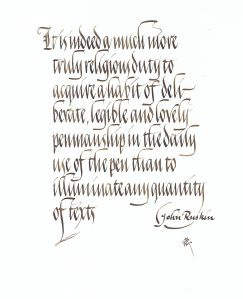
For speed and ease of writing most styles were italicised and various hands developed. Secretary, Chancery, various forms of Copperplate alongside the various types that were being carved and cast to be used by the early printing press and even more now as digitisation comes to the fore. Today we briefly mentioned Italic as one of the forms to concentrate on when building a portfolio of lettering styles along with Roman Capitals, a Roundhand, a Blackletter, Uncial and perhaps one of the Copperplate scripts.
Phew! 6000 years in 20 minutes. Now It is now time for the students to go to work. First they were invited to have a go with markers, pencils etc on the paper spread around the walls.
This next sequence of six photos, courtesy of Miss S. Lavin.
Then with my usual beginners tool set of double pencils, guideline sheets and model Roundhand and Roman alphabets it didn’t take them long to really impress Gill and I with their enthusiasm and with some really nicely formed letters.
We also had time for a very enjoyable, for me, question and answer session but only a few moments, as parents arrived to pick up their offspring, to search through my tool box and show just some of my fountain pens, poster pens, dip pens, hand made quills, reeds, bamboo pens etc.
Many thanks to the students and to the staff, firstly for the invitation, then for making our visit such an enjoyable experience, and for keeping the tea flowing. We hope this has begun, for some, a life long interest in the wonderful world of letters. We shall look forward to our next visit.
Cheers.
Bill and of course, Gill.







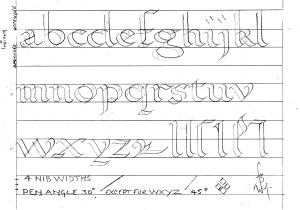
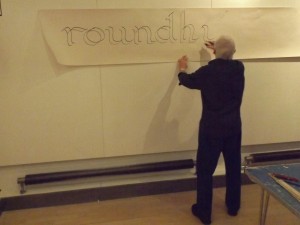




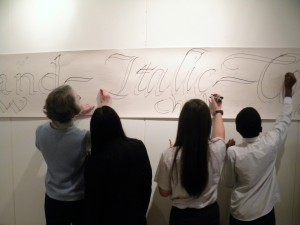
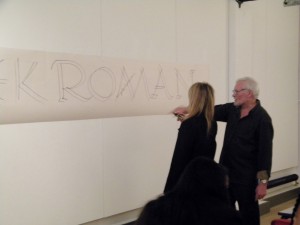
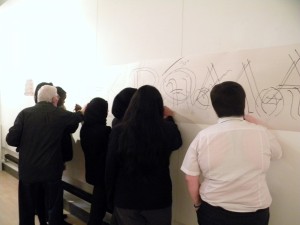

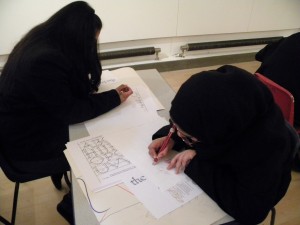








What lucky students! And what an excellent class structure.
LikeLike
Thanks Moya. The fruit of some years of experience in workshops. Crammed more into an hour and a half than I might have thought possible even one year ago and still had time for plenty of practical work. All due to the total concentration and diligence of the students.
LikeLike
Lovely blog Bill and a lovely experience for our Arts Award students. Huge thanks once again to you and Gill for giving up your time to run this valuable workshop with us! Hope to see you again soon!
LikeLike
Aah! Thanks Sam.
The pleasure was all ours.
LikeLike